Aquatic annelids (like Nereis) possess lateral appendages called ______________, which help in swimming.
visceral hump
parapodia
radula
spicules
Correct Answer :
B. parapodia
Nereis is a genus of polychaete worms in the family nereidae. It possesses setae and parapodia. Parapodia are paired, lateral appendages extending from the body segments.
Related Questions
Which of the following character is absent in all chordates?
Diaphragm
Coelom
Pharyngeal gill clefts
Dorsal nerve cord
The figure given below shows the germinal layers marked as A, B, C and D. Identify the label showing undifferentiated layer and its location?
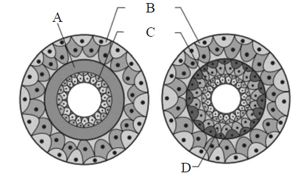
A, Between B & C
B, Between A & C
C, Between C & D
D, Between A & B
Which of the following traits is not shared by both sea anemones and jellyfish ?
A medusa as the dominant stage in the life cycle.
Possession of a gastro vascular cavity.
Sexual reproduction.
Nematocysts present on the tentacles.
Which of the following statements is without exception in sponges ?
They all have calcareous spicules.
They have high regenerative power.
They are found only in marine water.
They are all radially symmetrical.
Column-I contains organisms and column-II contains their exeretory structures. Choose the correct match form the options given below.
| Column- I | Column -II |
|---|---|
| (Organism) | (Excretory structures) |
| A. Cockroach | I. Nephridia |
| B. Cat fish | II. Malpighian tubules |
| C. Earthworm | III. Kidneys |
| D. Balanoglossus | IV. Flame cells |
| E. Flatworm | V. Proboscis gland |
A I; B III; C II; D IV; E V
A III; B I; C II; D V; E IV
A II; B I; C III; D V; E IV
A II; B III; C I; D V; E IV
Which of the following sets of animals give birth to young ones?
Platypus, Penguin, Bat, Hippopotamus.
Shrew, Bat, Cat, Kiwi.
Kangaroo, Hedgehog, Dolphin, Loris.
Lion, Bat, Whale, Ostrich.
Which of the following class is being described by the given statements (i - iv)?
(i) They are found in a variety of habitats- polar ice-caps, deserts, mountains, forests, grasslands and dark caves.
(ii) Most unique mammalian characteristic is the presence of mammary glands by which the young ones are nourished.
(iii) Heart is four-chambered.
(iv) Sexes are separate and fertilization is internal.
Reptilia
Aves
Mammalia
Amphibia
Which of the following is a connecting link between invertebrates and non-invertebrates?
Sphenodon
Balanoglossus
Tadpole larva
Crocodile
__________ is responsible for maintaining the current of water in sponge.
Osculum
Porocytes
Spongocoel
Choanocytes
In phylum arthropoda, excretion takes place through
nephridia
flame cells
malphigian tubules
gills
In which of the phylum, excretory organ like proboscis gland is present?
Hemichordata
Chordata
Echinodermata
Annelida
Match the terms/feature given in column I with their examples given in column II and select the correct match from the option given below.
| Column-I | Column-II |
|---|---|
| (Term/Feature) | (Examples) |
| A. Gregarious pest | i. Hirudinaria |
| B. Vector | ii. Planaria |
| C. Oviparous with | iii. Sepia indirect development |
| D. Metameres | iv. Aedes |
| E. High regeneration | v. Locust capacity |
A - i, B - ii, C - iii, D - iv, E - v
A - iii, B - v, C - ii, D - iv, E - i
A - iii, B - i, C - v, D - ii, E - iv
A - v, B - iv, C - iii, D - i, E - ii
Hemichordates have now been placed with the nonchordates, close to echinoderms, because true
notochord is absent.
pharyngeal gill-slits are lacking.
dorsal nerve cord is absent.
heart is lacking.
Identify the figures A, B and C and choose the correct option.

A - Male Ascaris, B - Hirudinaria (leech), C- Nereis
A - Female Ascaris, B - Nereis, C-Hirudinaria (leech)
A - Female Ascaris B- Hirudinaria (leech), C - Nereis
A - Male Ascaris, B - Nereis, C- Hirudinaria (leech)
Which of the following animal contains respiratory organs like, gills, book gills, book lungs or tracheal system?
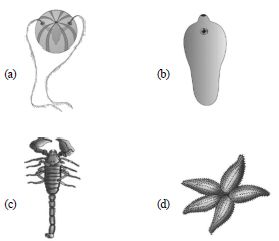
Click to check answer
Click to check answer
Click to check answer
Click to check answer
Which of the following class is being correctly described by given statements (i - iv)?
(i) All living members of this class are ectoparasites on some fishes.
(ii) They have a sucking and circular mouth without jaws.
(iii) Circulation is of closed type.
(iv) They are marine but migrate for spawning to fresh water. After spawing, within a few days they die.
Cyclostomata
Chondrichthyes
Osteichthyes
Amphibia
Identify the figures and select the correct option
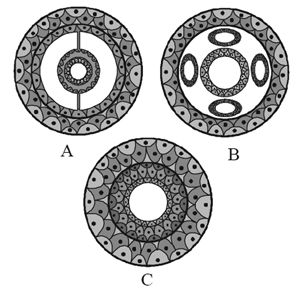
A - Pseudocoelomate; B - Coelomate, C-Acoelomate
A - Coelomate, B - Pseudocoelomate, C- Acoelomate
A - Coelomate; B- Acoelomate; C - Pseudocoelomate
A - Coelomate; B- Acoelomate; C-Eucoelomate
The given figures of animals (A & B) are distinguished on the basis of symmetry. Select the correct option which shows the type of symmetry and its description against the animals.
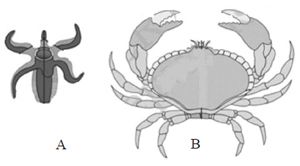
A : Biradial, organisms is divided into unequal halves by any plane through the central axis.
B: Bilateral, body is divided into equivalent right and left halves by only one plane.
A: Asymmetrical, organisms is not divided into equal halves by any plane through the central axis.
B: Radial, in which any plane passing through the central axis of the body divides the organism into two identical halves.
Which of the following statement(s) is/are correct regarding phylum mollusca?
They are bilaterally symmetrical, triploblastic and coelomate animals.
Body is covered by a calcareous shell and is unsegmented with a distinct head, muscular foot and visceral hump.
The mouth contains a file-like rasping organ for feeding, called radula.
All of the above
Which of the following statement(s) is/are correct regarding class aves?
(i) The forelimbs are modified into wings and the hindlimbs generally have scales and are modified for walking, swimming or clasping the tree branches.
(ii) Heart is completely four-chambered.
(iii) They are warm- blooded (homoiothermous) animals i.e., they are able to maintain a constant body temperature.
(iv) They are oviparous and development is direct.
Both (i) and (iii)
Both (i) and (iv)
(i), (ii) and (iii)
All of these
Which of the following statements is incorrect ?
Prawn has two pairs of antennae.
Nematocysts are characteristic feature of the phylum cnidaria.
Millipedes have two pairs of appendages in each segment of the body.
Animals that belong to phylum porifera are exclusively marine.
Which of the following is an incorrect statement regarding flatworms ?
They are acoelomates.
They are bilaterally symmetrical.
They lack a digestive system.
They have a circulatory system.
The following statement are associated with the occurrence of notochord. Identify the incorrect statement.
It is present only in larval tail in ascidians.
It is replaced by a vertebral column in adult frog.
It is absent throughout the life in humans from the very beginning.
It is present throughout life in Amphioxus.
Select the incorrect feature of mollusca from the given statements.
- Terrestrial or aquatic animals having cellular system level of organization.
- Radial symmetrical and acoelomate animals and possesses two germinal layers.
- A file like rasping organ called radula is present.
- Usually dioecious and viviparous animals.
- Examples include Pila, Octopus, and Dentalium.
(i) and (ii) only
(ii) and (iv) only
(i), (ii) and (iv) only
All the five statements.
Refer the given figures A, B, C and D and identify the option which shows their correct name.
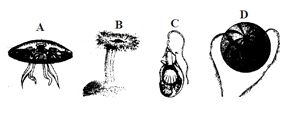
A - Pleurobrachia, B - Cnidoblast, C - Aurelia, D - Adamsia
A - Aurelia, B - Adamsia, C - Cnidoblast, D - Pleurobrachia
A - Cnidoblast, B - Pleurobrachia, C - Adamsia, D - Aurelia
A - Adamsia, B - Aurelia, C - Pleurobrachia, D - Cnidoblast
Which of the following belong to phylum arthropoda?
Bombyx and Apis
Laccifer and Anopheles
Locusta and Limulus
All of the above
Which of the following group of animals reproduces only by sexual means?
Ctenophora
Cnidaria
Porifera
Protozoa
Which of the follwoing statement(s) is/are correct?
(i) Organ systems in different group of animals show various patterns of complexities.
(ii) The digestive system in platyhelminthes has only a single opening to the outside of the body that serve as both mouth and anus, and is hence called complete.
(iii) In open type of circulatory system, the blood is pumped out of the heart and the cells and tissues are directly bathed in it.
(iv) In closed type, the blood is circulated through a series of vessels of varying diameters (arteries, veins and capillaries).
Only (i)
Both (ii) and (iii)
(i), (iii) and (iv)
All of these
Match the types of animals given in column I with their examples given in column II and choose the correct option.
| Column -I | Column -II |
|---|---|
| (Types of animals) | (Examples) |
| A. Limbless reptiles | I. Elephant |
| B. Jawless vertebrates | II. Lamprey |
| C. Flightless bird | III. Ichthyophis |
| D. Largest | IV. Ostrich terrestrial animal |
| E. Limbless amphibia | V. Cobra |
A II; B V; C IV; D I; E III
A V; B II; C IV; D I; E III
A V; B II; C I; D IV; E III
A V; B IV; C II; D I; E III
Flame cells present in platyhelminthes, are specialized in
respiration and absorption.
osmoregulation and circulation.
respiration and excretion.
osmoregulation and excretion.
